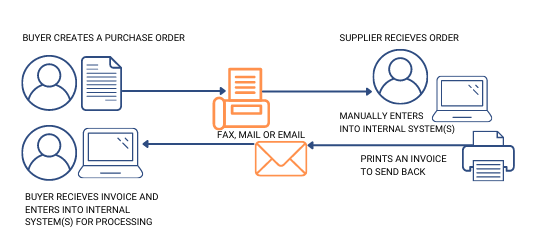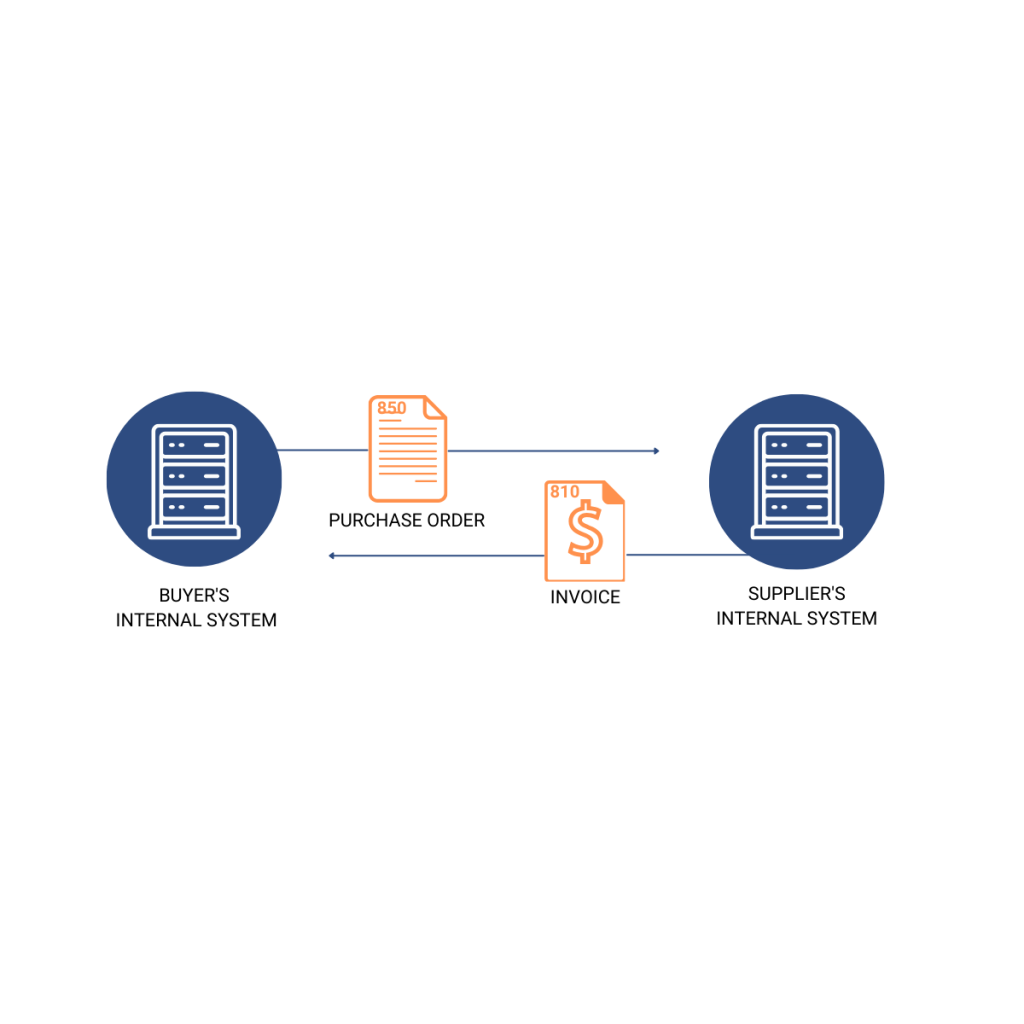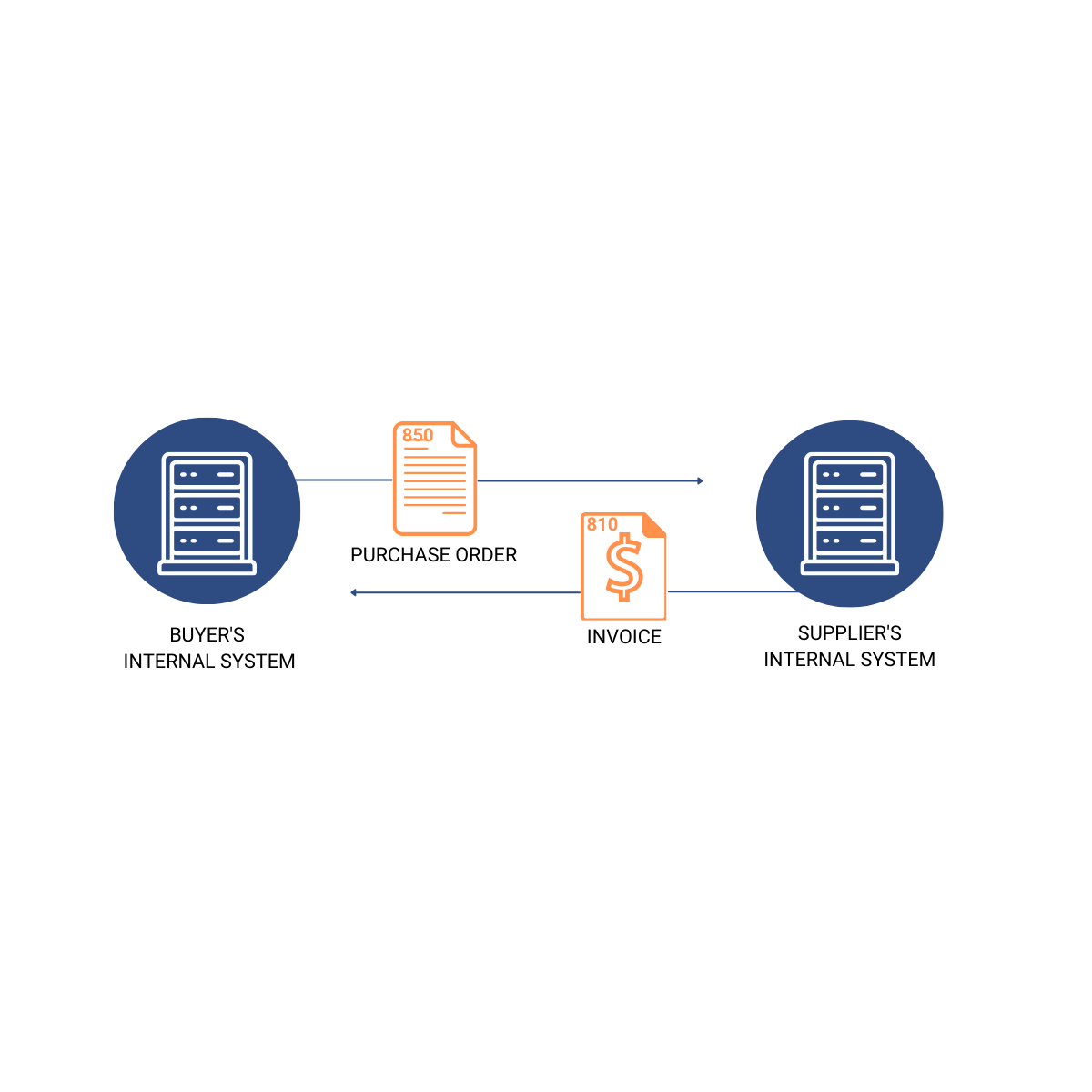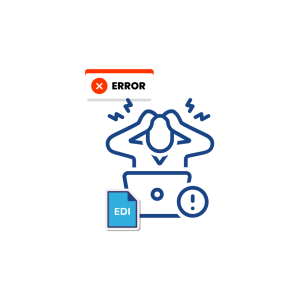Introduction
What Does EDI Stand For?
EDI stands for Electronic Data Interchange which is the exchange of large amounts of information computer-to-computer in a specified format between business partners.
EDI has been in use since the 1960s; however, in more recent years, EDI came to play a key role in enabling supply chain automation, digital transformation, and B2B business process automation.
More than 85% of all electronic business transactions take place using EDI.
This method of exchanging documents is used in industries including retail, banking, high-tech, manufacturing, and services.
Direct EDI saves time and costs associated with manual data entry, eliminating the need to mail, email, fax, and manually process documents. Electronic Data Interchange (EDI) follows a certain set of standards that allow the sender’s documents to flow straight through to the intended application on the receiver’s end. This enables the processing and return of documents to be accepted and processed immediately.
The Evolution of EDI
EDI has been around for several decades, evolving alongside technological advancements.
Here’s a brief timeline:
1960s: Initial development of EDI concepts in the transportation and logistics sector.
1970s: The first EDI standards were introduced to facilitate document exchange between businesses.
1980s: Widespread adoption of ANSI X12 and EDIFACT standards, making EDI a global business practice.
1990s: EDI Integration with ERP systems and the rise of EDI networks (Value-Added Networks – VANs) for secure data transmission.
2000s- Present: The growth of cloud-based EDI, EDI API-based integrations, and hybrid EDI solutions for enhanced connectivity.
Manual Process (No EDI)

Common Errors with No EDI System
- Missing or lost documents
- Time delays
- Hard and soft costs
- Pricing inconsistencies
- Weak security
- Poor customer relationship
Staying compliant with your business partners’ EDI requirements is crucial to a positive customer relationship.
Automated EDI Process
- Immense savings in time
- Significant cost savings
- Reduced drain on resources overall
- Reduced error rates in data transfer (we almost want to say ‘eliminate’ here!)
- Improved security of data being transferred
- Reliability – you can have confidence that data is reaching its destination

Information moves directly from one internal system in one organization to a internal system in another.
Key Benefits of EDI
Businesses across industries implement EDI to improve efficiency and enhance their supply chain operations. Here are some major EDI advantages:
1. Cost Savings
Reduces printing, paper, and postage expenses.
Minimizes manual labor and associated costs.
2. Faster Transactions
Reduces document processing time from days to minutes.
Enhances order fulfillment speed.
3. Error Reduction
Eliminates data entry mistakes caused by manual processes.
Improve data accuracy in transactions.
4. Enhanced Security & Compliance
Provides encrypted and secure data exchange.
Ensures compliance with industry regulations (e.g., HIPAA, GDPR, SOX).
5. Improved Business Relationships
Strengthens partnerships with trading partners by ensuring timely transactions.
Facilitates seamless communication across global networks.
What are EDI Standards?
EDI standards define the location and order of information in a specific document format.
- EDI Standards eliminate company-to-company fluctuations, allowing each business partner’s computer system to speak the same language.
- Standards describe the format in which the data will be sent and received.
- Most common standard sets: American National Standards Institute ANSI X12 in North America, UN/EDIFACT globally
EDI integration enables businesses to share a wide range of document types, the most common are purchase orders (EDI 850) and EDI 810 invoices.
Businesses will need an EDI translator to translate the EDI format so the data can be used by their internal systems and thus enable straight-through processing of documents. These translators can either be an in-house software or an EDI service provider
Industries That Use EDI
EDI is implemented across various sectors, improving efficiency and accuracy in data exchange. Some key industries include:
Retail: Automated ordering, invoicing, and inventory management.
Healthcare: Secure transmission of patient records and insurance claims.
Logistics & Transportation: Real-time shipment tracking and freight management.
Automotive: Streamlined supply chain communication and just-in-time manufacturing.
Manufacturing: Seamless procurement, supplier collaboration, and production planning.
Finance & Banking: Fast and secure transaction processing.
Types of EDI Solutions



Integrated EDI Solution
An Integrated EDI solution translates your inbound documents, like purchase orders, from your trading partners’ EDI files into a format that can be imported directly into your ERP, accounting or other business system. The solution grows easily as your business grows and adding new customers is easy. Translation is fast and reliable – so you can focus on your business.
Cloud EDI Solution
Communication of EDI messages via the Internet. Cloud EDI is most often considered in contrast to doing EDI via a VAN (Value Added Network). In this situation, Cloud EDI is simply a communications pathway, where EDI data is passed between trading partners using Internet protocols. It offers functionality, automation, and control to organizations looking to automate their processes.
EDI Outsourcing
EDI outsourcing is also suitable if you have implemented a fully integrated EDI-compliant system but still have partners who want to send you faxes. Commport’s managed EDI Service Bureau can be your clearinghouse for fax automation. We can process all of your paper-based documents and generate their electronic equivalents in the format of your preference for electronic integration.
Conclusion
EDI (Electronic Data Interchange) is a critical component of modern business communication, enabling seamless, secure, and automated data exchange between organizations. With its numerous benefits, including cost savings, accuracy, and efficiency, EDI is widely adopted across various industries.
As businesses continue to embrace digital transformation, EDI will remain a fundamental tool in streamlining supply chains, financial transactions, and inter-business communications. Investing in modern EDI solutions will ensure companies stay ahead in a highly competitive marketplace.
Download: EDI Buyers Guide
Unlock the full potential of your supply chain with our comprehensive EDI Buyer's Guide — your first step towards seamless, efficient, and error-free transactions
Frequently Asked Questions
EDI stands for Electronic Data Interchange. It is a standardized electronic communication method used by businesses to exchange various business documents, such as purchase orders and invoices, in a structured and machine-readable format.
Unlike traditional paper-based methods, EDI allows businesses to exchange documents electronically in a standardized format. This eliminates the need for manual data entry, reduces errors, and accelerates the speed of transactions between trading partners.
EDI is crucial in modern business transactions as it streamlines communication, reduces costs associated with paper-based processes, minimizes errors, and enhances overall efficiency. It fosters quicker and more accurate exchange of information between businesses, contributing to a more agile and responsive supply chain.
EDI facilitates the exchange of various business documents, including purchase orders, invoices, shipping notices, and more. The specific documents exchanged depend on the nature of the business transaction and the requirements of the trading partners involved.
EDI is suitable for businesses of all sizes. Many EDI solutions are scalable and can be adapted to meet the specific needs and volumes of small enterprises, offering them the same advantages in terms of efficiency, accuracy, and improved collaboration with trading partners.





